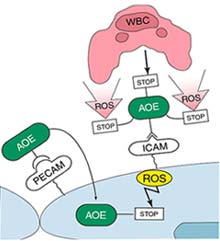Teaming up to attack free radicals

Protecting endothelial cells with targeted antioxidant enzymes (AOE). The AOE, catalase in this case, connected to an antibody binds to endothelial cells (EC) and detoxifies reactive oxygen species (ROS), which can cause free radical damage.
Antibody/enzyme combo protects transplanted lungs from oxidative stress damage
Researchers based at the University of Pennsylvania School of Medicine have combined the precision of antibodies with the power of an antioxidant enzyme to create a new way to protect transplanted lungs from oxidative stress – also known as free radical damage – before and during transplantation.
Their findings, presented in the April edition of Nature Biotechnology and available online now, demonstrate the therapeutic potential of immunotargeting as a drug delivery system. Oxidative stress causes some degree of damage in 15-20% of all transplants and is the leading cause of acute lung graft failure. By protecting the lungs from damage, the researchers have determined that they can increase lung-graft survivability and the length of time a donated lung can be kept in cold storage.
“It is a simple theory that has been difficult to put into practice: get an antibody that will go to a specific target and attach a therapeutic to go along for the ride,” said Vladimir R. Muzykantov, MD, PhD, assistant professor in Penn’s Department of Pharmacology. “Endothelial cells – the cells that line the interior of blood vessels – bristle with possible targets for antibodies to cling to as they rush through the bloodstream. This targeted delivery of drugs has enormous potential for treating a variety of endothelial cell disorders, including cancer and cardiovascular and pulmonary disease.”
To protect transplanted lungs against oxidative stress, Muzykantov and his colleagues chemically coupled catalase, an enzyme that detoxifies oxidants, with an antibody for the platelet-endothelial cell adhesion molecule-1 (PECAM). Their findings in animal models show that anti-PECAM/catalase hybrid construct strengthened antioxidant defenses, lessened free-radical damage, reduced transplantation-associated acute lung injury, and improved the overall survivability of the lung graft.
“All organs, and lungs in particular, suffer a great deal during the time they are removed, transported, and put in to another body.” said Steven M. Albelda, MD, vice chief of the Pulmonary, Allergy, and Critical Care Division of Penn’s Department of Medicine. “In fact, our findings show that the anti-PECAM/catalase is most effective when given to the donor prior to organ removal, as it protects the lung when it is in cold storage.”
According to the researchers, the PECAM molecule was an attractive target because there are a great many of them on the surface endothelial cells, even during times of physiological stress. Following transplant, the researchers were able to determine that the anti-PECAM/catalase conjugates accumulated in the blood vessels of the lungs and retained their activity for a prolonged period during cold storage, transplantation, and the restoration of blood flow.
“Endothelial cells are particularly vulnerable to oxidative stress but, unfortunately, most antioxidant enzymes do not last very long in the bloodstream,” said Muzykantov. “By combining an antioxidant with an antibody, we can direct an enzyme to where it needs to be and keep it there.”
According to Muzykantov, their research provides a proof-of-concept for this method of drug delivery. They are seeking to further streamline the process by which they can join the anti-PECAM antibody to the catalase enzyme in order to make the anti-PECAM/catalase into a more effective and easily produced therapeutic.
“This immunotargeting approach may be extremely valuable,” said Muzykantov. “It could reduce injury during clinical lung transplantation and may dramatically increase the amount of time that lung grafts are stored, thereby increasing the pool of donor lungs for use in clinical transplantation. This approach could also likely be applied to other organ transplants.”
Other Penn researchers involved in this paper include Melpo Christofidou-Solomidou from the Department of Medicine, and Thomas D. Sweitzer, Donald G. Buerk, and Silvia Muro from Penn’s Institute for Environmental Medicine. Researchers contributing from other institutions include Charalambos C. Solomides of Temple University, and Benjamin D. Kozower and G. Alexander Patterson of Washington University.
Funding for this research was provided by the National Institutes of Health and the American Lung Association. The anti-PECAM antibody was a gift from Dr. Marian Nakada, Centocor, Inc., of Malvern, Pennsylvania.
Media Contact
All latest news from the category: Health and Medicine
This subject area encompasses research and studies in the field of human medicine.
Among the wide-ranging list of topics covered here are anesthesiology, anatomy, surgery, human genetics, hygiene and environmental medicine, internal medicine, neurology, pharmacology, physiology, urology and dental medicine.
Newest articles

Innovative 3D printed scaffolds offer new hope for bone healing
Researchers at the Institute for Bioengineering of Catalonia have developed novel 3D printed PLA-CaP scaffolds that promote blood vessel formation, ensuring better healing and regeneration of bone tissue. Bone is…

The surprising role of gut infection in Alzheimer’s disease
ASU- and Banner Alzheimer’s Institute-led study implicates link between a common virus and the disease, which travels from the gut to the brain and may be a target for antiviral…

Molecular gardening: New enzymes discovered for protein modification pruning
How deubiquitinases USP53 and USP54 cleave long polyubiquitin chains and how the former is linked to liver disease in children. Deubiquitinases (DUBs) are enzymes used by cells to trim protein…



